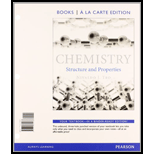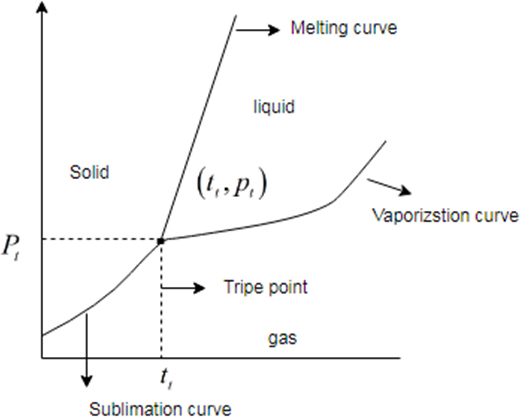
Chemistry: Structures and Properties, Books a la Carte Plus MasteringChemistry with eText -- Access Card Package
1st Edition
ISBN: 9780321974617
Author: Nivaldo J. Tro
Publisher: PEARSON
expand_more
expand_more
format_list_bulleted
Question
Chapter 13, Problem 67E
Interpretation Introduction
Interpretation:
You have to find out in which state substance exist on the earth surface at sea-level It is given that substance has a triple point at a temperature of and a pressure is atmospheres.
Concept introduction:
Generic phase diagram of substance

Form the above diagram it becomes clear that at pressure decreased and temperature increased then equilibrium must be shift towards gaseous sate.
Expert Solution & Answer
Want to see the full answer?
Check out a sample textbook solution
Students have asked these similar questions
Lab Data
The distance entered is out of the expected range.
Check your calculations and conversion factors.
Verify your distance. Will the gas cloud be closer to the cotton ball with HCI or NH3?
Did you report your data to the correct number of significant figures?
- X
Experimental Set-up
HCI-NH3
NH3-HCI
Longer Tube
Time elapsed (min)
5 (exact)
5 (exact)
Distance between cotton balls (cm)
24.30
24.40
Distance to cloud (cm)
9.70
14.16
Distance traveled by HCI (cm)
9.70
9.80
Distance traveled by NH3 (cm)
14.60
14.50
Diffusion rate of HCI (cm/hr)
116
118
Diffusion rate of NH3 (cm/hr)
175.2
175.2
How to measure distance and calculate rate
For the titration of a divalent metal ion (M2+) with EDTA, the stoichiometry of the reaction is typically:
1:1 (one mole of EDTA per mole of metal ion)
2:1 (two moles of EDTA per mole of metal ion)
1:2 (one mole of EDTA per two moles of metal ion)
None of the above
Please help me solve this reaction.
Chapter 13 Solutions
Chemistry: Structures and Properties, Books a la Carte Plus MasteringChemistry with eText -- Access Card Package
Ch. 13 - Determine what state this substance is in at 1 atm...Ch. 13 - Prob. 2SAQCh. 13 - Prob. 3SAQCh. 13 - Prob. 4SAQCh. 13 - Prob. 5SAQCh. 13 - Prob. 6SAQCh. 13 - Prob. 7SAQCh. 13 - Prob. 8SAQCh. 13 - Prob. 9SAQCh. 13 - Prob. 10SAQ
Ch. 13 - What is a phase diagram?Ch. 13 - Draw a generic phase diagram and label its...Ch. 13 - What is the significance of crossing a line in a...Ch. 13 - What is graphene? Why is graphene unique?Ch. 13 - Prob. 5ECh. 13 - What is a crystalline lattice? How is the lattice...Ch. 13 - Prob. 7ECh. 13 - Prob. 8ECh. 13 - What is the difference between hexagonal closest...Ch. 13 - What are the three basic types of solids and the...Ch. 13 - Prob. 11ECh. 13 - What kinds of forces hold each of the three basic...Ch. 13 - Prob. 13ECh. 13 - Prob. 14ECh. 13 - Prob. 15ECh. 13 - Prob. 16ECh. 13 - Prob. 17ECh. 13 - Prob. 18ECh. 13 - Prob. 19ECh. 13 - Consider the phase diagram for iodine shown here....Ch. 13 - Prob. 21ECh. 13 - Prob. 22ECh. 13 - Prob. 23ECh. 13 - Prob. 24ECh. 13 - Prob. 25ECh. 13 - An X-ray beam of unknown wavelength is diffracted...Ch. 13 - Prob. 27ECh. 13 - Determine the coordination number for each...Ch. 13 - Prob. 29ECh. 13 - Molybdenum crystallizes with the body-centred unit...Ch. 13 - Prob. 31ECh. 13 - An atom has a radius of 142 pm and crystallizes in...Ch. 13 - Rhodium has a density of 12.41 g / cm3 and...Ch. 13 - Barium has a density of 3.59 g/cm3 and...Ch. 13 - Prob. 35ECh. 13 - Palladium crystallizes with a face-centered cubic...Ch. 13 - Prob. 37ECh. 13 - Identify each solid as molecular, ionic, or...Ch. 13 - Which solid has the highest melting point? Why?...Ch. 13 - Which solid has the highest melting point? Why?...Ch. 13 - Which solid in each pair has the higher melting...Ch. 13 - Which solid in each pair has the higher melting...Ch. 13 - Prob. 43ECh. 13 - Prob. 44ECh. 13 - Prob. 45ECh. 13 - Prob. 46ECh. 13 - The unit cells for cesium chloride and barium(ll)...Ch. 13 - Prob. 48ECh. 13 - Prob. 49ECh. 13 - Prob. 50ECh. 13 - Prob. 51ECh. 13 - Prob. 52ECh. 13 - Prob. 53ECh. 13 - Prob. 54ECh. 13 - Prob. 55ECh. 13 - Prob. 56ECh. 13 - Prob. 57ECh. 13 - The density of an unknown metal is 12.3 g/cm3 and...Ch. 13 - Prob. 59ECh. 13 - Consider a planet where the pressure of the...Ch. 13 - An unknown metal is found to have a density of...Ch. 13 - Prob. 62ECh. 13 - Potassium chloride crystallizes in the rock salt...Ch. 13 - Calculate the fraction of empty space in cubic...Ch. 13 - Prob. 65ECh. 13 - Prob. 66ECh. 13 - Prob. 67E
Knowledge Booster
Similar questions
- Indicate the products obtained by mixing 2,2-dimethylpropanal with acetaldehyde and sodium ethoxide in ethanol.arrow_forwardSynthesize 2-Ethyl-3-methyloxirane from dimethyl(propyl)sulfonium iodide using the necessary organic or inorganic reagents. Draw the structures of the compounds.arrow_forwardSynthesize 2-Hydroxy-2-phenylacetonitrile from phenylmethanol using the necessary organic or inorganic reagents. Draw the structures of the compounds.arrow_forward
- Synthesize N-Methylcyclohexylamine from cyclohexanol using the necessary organic or inorganic reagents. Draw the structures of the compounds.arrow_forwardSynthesize N-Methylcyclohexylamine from cyclohexanol using the necessary organic or inorganic reagents. Draw the structures of the compounds.arrow_forwardIf possible, please provide the formula of the compound 3,3-dimethylbut-2-enal.arrow_forward
- Synthesize 1,4-dibromobenzene from acetanilide (N-phenylacetamide) using the necessary organic or inorganic reagents. Draw the structures of the compounds.arrow_forwardIndicate the products obtained by mixing (3-oxo-3-phenylpropyl)triphenylphosphonium bromide with sodium hydride.arrow_forwardWe mix N-ethyl-2-hexanamine with excess methyl iodide and followed by heating with aqueous Ag2O. Indicate the major products obtained.arrow_forward
- Indicate the products obtained by mixing acetophenone with iodine and NaOH.arrow_forwardIndicate the products obtained by mixing 2-Propanone and ethyllithium and performing a subsequent acid hydrolysis.arrow_forwardIndicate the products obtained if (E)-2-butenal and 3-oxo-butanenitrile are mixed with sodium ethoxide in ethanol.arrow_forward
arrow_back_ios
SEE MORE QUESTIONS
arrow_forward_ios
Recommended textbooks for you
 Chemistry: Principles and PracticeChemistryISBN:9780534420123Author:Daniel L. Reger, Scott R. Goode, David W. Ball, Edward MercerPublisher:Cengage Learning
Chemistry: Principles and PracticeChemistryISBN:9780534420123Author:Daniel L. Reger, Scott R. Goode, David W. Ball, Edward MercerPublisher:Cengage Learning General Chemistry - Standalone book (MindTap Cour...ChemistryISBN:9781305580343Author:Steven D. Gammon, Ebbing, Darrell Ebbing, Steven D., Darrell; Gammon, Darrell Ebbing; Steven D. Gammon, Darrell D.; Gammon, Ebbing; Steven D. Gammon; DarrellPublisher:Cengage Learning
General Chemistry - Standalone book (MindTap Cour...ChemistryISBN:9781305580343Author:Steven D. Gammon, Ebbing, Darrell Ebbing, Steven D., Darrell; Gammon, Darrell Ebbing; Steven D. Gammon, Darrell D.; Gammon, Ebbing; Steven D. Gammon; DarrellPublisher:Cengage Learning Chemistry: The Molecular ScienceChemistryISBN:9781285199047Author:John W. Moore, Conrad L. StanitskiPublisher:Cengage Learning
Chemistry: The Molecular ScienceChemistryISBN:9781285199047Author:John W. Moore, Conrad L. StanitskiPublisher:Cengage Learning ChemistryChemistryISBN:9781305957404Author:Steven S. Zumdahl, Susan A. Zumdahl, Donald J. DeCostePublisher:Cengage Learning
ChemistryChemistryISBN:9781305957404Author:Steven S. Zumdahl, Susan A. Zumdahl, Donald J. DeCostePublisher:Cengage Learning
 Chemistry for Engineering StudentsChemistryISBN:9781337398909Author:Lawrence S. Brown, Tom HolmePublisher:Cengage Learning
Chemistry for Engineering StudentsChemistryISBN:9781337398909Author:Lawrence S. Brown, Tom HolmePublisher:Cengage Learning

Chemistry: Principles and Practice
Chemistry
ISBN:9780534420123
Author:Daniel L. Reger, Scott R. Goode, David W. Ball, Edward Mercer
Publisher:Cengage Learning

General Chemistry - Standalone book (MindTap Cour...
Chemistry
ISBN:9781305580343
Author:Steven D. Gammon, Ebbing, Darrell Ebbing, Steven D., Darrell; Gammon, Darrell Ebbing; Steven D. Gammon, Darrell D.; Gammon, Ebbing; Steven D. Gammon; Darrell
Publisher:Cengage Learning

Chemistry: The Molecular Science
Chemistry
ISBN:9781285199047
Author:John W. Moore, Conrad L. Stanitski
Publisher:Cengage Learning

Chemistry
Chemistry
ISBN:9781305957404
Author:Steven S. Zumdahl, Susan A. Zumdahl, Donald J. DeCoste
Publisher:Cengage Learning


Chemistry for Engineering Students
Chemistry
ISBN:9781337398909
Author:Lawrence S. Brown, Tom Holme
Publisher:Cengage Learning